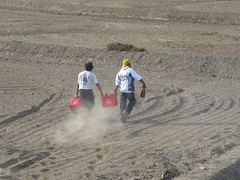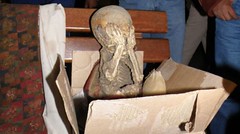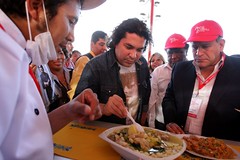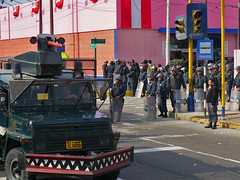Chuschi’s new legacy
The district of Chuschi in Ayacucho doesn’t want to be remembered as the location from which the Shining Path began is blood-thirsty armed struggle in the 1980s. Today its population are trying to build a new legacy, a program of social development that allows them to work and benefit from their own natural resources. The program, financed by Oxfam, has shown them everything from how to distribute spaces within their homes to techniques for water use, irrigation and cultivation.
 Now, without fear and violence, Chuschi is still here, found just three hours outside the city of Huamanga-Ayacucho, deep in Peru’s Andes mountains. Its small central plaza is full of stalls where people from surrounding communities sell fruit and vegetables while children run to-and-fro. Though you might now see little telephone cabins offering an internet connection to the outside world, poverty is still very evident.
Now, without fear and violence, Chuschi is still here, found just three hours outside the city of Huamanga-Ayacucho, deep in Peru’s Andes mountains. Its small central plaza is full of stalls where people from surrounding communities sell fruit and vegetables while children run to-and-fro. Though you might now see little telephone cabins offering an internet connection to the outside world, poverty is still very evident.
It is this deep-seated poverty that has attracted the eyes of both Government-sponsored groups, NGOs and charities like Oxfam. The objective is to empower the population so that they are able to make better use of their land, their natural resources and their own abilities, improving their quality of life and without harming the environment.
 The Cancho Vilca family live in the community of San Juan de Uchuyri in the district of Chuschi. After receiving outside help, their home is now well distributed, making the best and most hygienic use of space. Victoria tells of her experience. “Before I didn’t know how to work and I didn’t know it was important that my children study. I didn’t have any vegetables and the food I gave to my children wasn’t good”. Until two years ago, all the family slept in a single room without windows. When outside assistance arrived the family were shown the benefits of having a separate living space, separate areas for their animals, separate rooms for everyone and how to produce their own vegetables such as carrots, beetroot, and artichokes – even fruits such as apples, lúcuma and aguaymanto.
The Cancho Vilca family live in the community of San Juan de Uchuyri in the district of Chuschi. After receiving outside help, their home is now well distributed, making the best and most hygienic use of space. Victoria tells of her experience. “Before I didn’t know how to work and I didn’t know it was important that my children study. I didn’t have any vegetables and the food I gave to my children wasn’t good”. Until two years ago, all the family slept in a single room without windows. When outside assistance arrived the family were shown the benefits of having a separate living space, separate areas for their animals, separate rooms for everyone and how to produce their own vegetables such as carrots, beetroot, and artichokes – even fruits such as apples, lúcuma and aguaymanto.
Damián, man of the house, explains that “all this change is part of a community plan that is our guide. We were scared to go to the lessons they gave us, but when we began to work we saw we had learnt new methods.”
The lessons and work he speaks of consisted of classes for all the family in which they learnt how to organise and analyse, predict future needs and make plans. Later they were able to put what they learnt to use themselves, their quality of life improving significantly. By selling what they have learnt to grow, they are now able to send their children to school.
The Dueñas family have been through the same process. Soilo highlights the family’s honey production. “Before I didn’t know anything about managing bees, but I began to work on it after I learnt in the lessons. Now I have 30 hives and I make honey. We want to become small business owners and offer our products to the market.” The entire family works as a team following an action plan they have created. They have turned themselves into one of the town’s most successful families and are helping others. They explain that they value the transmission of knowledge and learning, the are keen to pass on what they know.
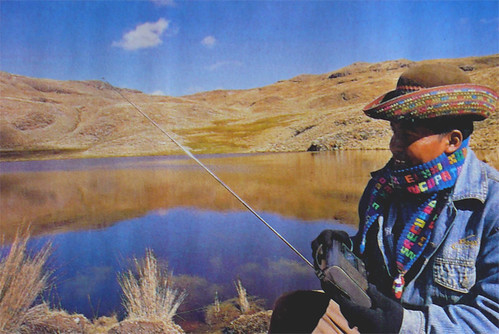 At the community level similar work is being done on a larger scale. Community leaders are taught and they are then charged with passing on this knowledge and organising larger scale projects.
At the community level similar work is being done on a larger scale. Community leaders are taught and they are then charged with passing on this knowledge and organising larger scale projects.
At 4,800 metres above sea level sits a large artificial lake six metres deep. It was created by the Puncupata community, working together, who had been taught the needed engineering processes and about water management.
“It is a joy to work with and learn to make this lake, it makes our community strong”, Américo says, explaining that the water can also be used for their animals to drink. Plans are under way to build a canal from the lake to irrigate surrounding farmland during the dry season.
The Catalinayocc community has also made great strides forward. They were taught new irrigation techniques and about weather patterns. They are now able to make two harvest per year rather than one. Community leader Mario Mendoza explains, “it is vital to work in a team and work with well-thought-out plans”.
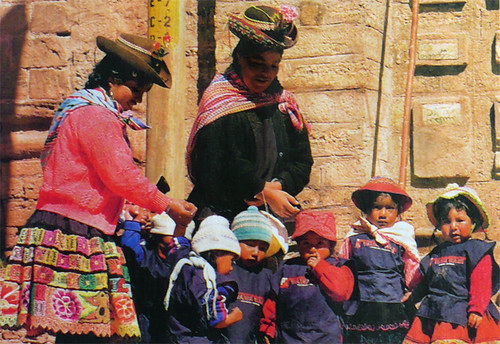 The project began in 2004, with both community and family level aims. The women, as representatives of their families, were the prime targets for family-level capacitation while community leaders were tasked with learning skills for larger-scale projects. It was found that even when only one family member attended the capacitation classes, what they had learnt was immediately passed on not only to other family members but to other members of their community.
The project began in 2004, with both community and family level aims. The women, as representatives of their families, were the prime targets for family-level capacitation while community leaders were tasked with learning skills for larger-scale projects. It was found that even when only one family member attended the capacitation classes, what they had learnt was immediately passed on not only to other family members but to other members of their community.
These rural people were immediately aware of the opportunity they had been given and took full advantage. Carlos Alviar, director of the NGO called CEDAP, explained that the communities were not afraid to work hard, not did they lack the motivation to learn, “they knew that they would see the benefits of their hard work”. Giovanna Vásquez, responsible for the Oxfam side of the project, says that this is a clear example of rural development strategies being put into effect successfully and that “they lead to clear reduction in poverty”.
The people of Chuschi have shown that they are not lacking in ability. Change is not determined by the amount of money or tools that can be donated, but instead by education, by empowering people with the knowledge they need to improve their situation themselves.




